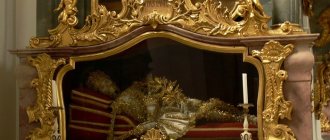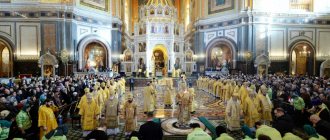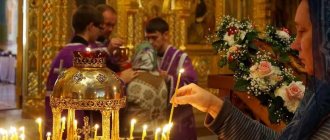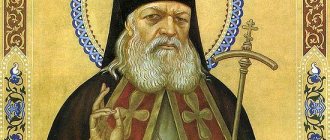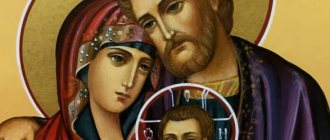Among the entire Orthodox people there are people who can be classified as “nominal” Christians. They go to church on Christmas or Easter and strive to perform all the rituals of “folk” Orthodoxy, i.e. they bake Easter cakes, consecrate vodka, swim in an ice hole at Epiphany, but inside they are ordinary laymen who deceive, steal and lead extremely indecent lives. To avoid such a frivolous and superficial attitude towards the church, ministers strive to convey to Christians in as much detail as possible the meaning of this or that sacrament - in order to prevent the spread of heresies, but to raise an intelligent and thinking flock.
Such rituals also include applying to an icon. In the 8th-10th centuries, the fires of iconoclasm burned because the ministers decided to understand the images higher, since people pressed so hard that they even bit off the gilded frame. How to venerate an icon correctly, and most importantly, why do it?
One should venerate icons with a special sense of awe and reverence.
How to correctly enter the church and approach the icons
Going to church is the duty of a Christian. Coming to a sacred place, a person strives to join the Divine Spirit and devote time to prayer and participation in the sacraments. Therefore, when going to church, you should renounce worldly thoughts and dreams. A woman must enter the temple with her head covered and in a skirt. Men, on the contrary, must remove their hats.
These days, with busy life and work schedules, people don't always have enough time to change into appropriate clothes. Therefore, priests are quite loyal to the appearance of parishioners. However, whenever possible, tradition should be respected.
The second important rule when entering the temple is the sign of the cross and a bow with prayer. A person is supposed to cross himself and bow while reading the Jesus Prayer: “Lord Jesus Christ, have mercy on me a sinner” or “In the name of the Father, Son and Holy Spirit, Amen!” The bow is made three times at the threshold of the church to enter. It is necessary to do this in order to tune in to the right mood in order to drive away evil thoughts and feelings inspired by the evil one.
Having crossed the threshold of the church, you are also supposed to cross yourself and bow to the sacred altar. If possible, you need to take a blessing from the priest, if this does not distract the servant of the Lord from prayer. According to tradition, first of all, you need to bow to the icon located on the lectern in the center of the temple. Usually, images of those saints and righteous people whose memory days are celebrated at the moment, or church relics, such as the Shroud or the relics of saints, are placed here. Then be sure to bow to Golgotha - the cross with the crucifix and other revered local shrines.
Pilgrimage
Having the gift of God, Matrona saved many people and was very kind to them. She had a bright face and a very gentle voice. She would pat everyone on the head, console them, and give them her due, and this made people feel better in their souls, they were comforted and calmed down. Although she herself was very sick, no one heard any complaints from her.
Matrona also visited the Kronstadt Cathedral in 1899. There, the Monk John of Kronstadt, at the end of the service, asked all the parishioners to make way and let Matrona through and said: “Matronushka, come, come to me. Here comes my shift—the eighth pillar of Russia.”
How to properly venerate an icon in church
There are two ways to venerate the icon - either kiss the image or touch the image with your forehead. The last method is called “attachment”. When approaching the image, you need to make the sign of the cross and bow from the waist. Then you can press your forehead to the icon. Usually you can touch the image in the lower part of the composition, falling as if at the feet of the Lord, the Mother of God or the holy righteous.
By kissing the icon, you can turn to the heavenly patron depicted on it with a prayer or request. At such moments, people can reveal the most painful corners of their hearts, and you can often see tears attached to the image in their eyes. This happens because the Lord, by His mercy, does not abandon people and gives them grace that touches their soul to the very depths. In Christianity, it is believed that when we touch an image with our forehead, we seem to embrace the saint depicted on it.
You can place a candle purchased in a church shop next to the image. The fire burning in the temple is Divine fire. He personifies the power of human faith and unquenchable hope for the victory of good in the world.
Biography
In November 1881, a girl was born into an ordinary Nikonov family in the village of Sebino, in the Tula province, who was named Matrona. She became the fourth child in the family, as she already had two brothers and a sister. Poor Matronushka was born blind, and they already wanted to leave her in an orphanage. However, the mother had a prophetic dream: she saw a beautiful white bird that sat on her chest, which had no eyes. The parents guessed that Matrona would become God's chosen child by the beneficial cloud of smoke at the moment of her birth. Already at the age of eight, she was strong and soon discovered the gift of a wise seer. Crowds of people began to come to her for help and healing. Matronushka became a real breadwinner in her family. And at the age of 18 her legs became paralyzed.
Is it necessary to kiss holy images in the temple?
Kissing an image, as described above, is a way of venerating an icon, when a person expresses his love and veneration for the saint by touching his lips. However, this method also has its own characteristics. Because, while expressing their respect and awe, people should remember humility and submission to the will of God.
Priests often teach parishioners that it is forbidden to kiss an icon with painted lips. Women want to look beautiful, and yet, the church is a place of renunciation of worldly thoughts and desires. Therefore, the best solution would be a complete absence of makeup on the face of a Christian woman. Leaving lipstick stains on the glass of images is not ethical.
The faces of saints are never kissed on icons - this is also wrong and disrespectful. It is better to touch the hands, feet, and robe of the heavenly patron with your lips. On some images of Jesus, for example, “The Savior Not Made by Hands” or icons of John the Baptist, you can kiss the image of the hair of the Forerunner and Christ.
Relics of Matrona of Moscow. Monastery
The funeral service was conducted by Archpriest Nikolai Golubtsov, who revered Mother Matrona, in the Church of the Deposition of the Robe. On May 4, the Sunday of the Holy Myrrh-Bearing Women, the burial of the holy old woman took place, at which a large number of believers gathered. She was buried at the Danilovsky cemetery at the request of her mother herself. This church was one of the few that operated in Moscow, so she always wanted to “hear the service.”
On March 8, 1998, with the blessing of Patriarch Alexy II, the incorrupt relics of Holy Mother Matrona were removed from the grave and were first taken to the Danilov Monastery, and then to the Pokrovsky Monastery.
Now pilgrims are always allowed to visit the relics of Matrona of Moscow from 6.00 to 20.00. They are placed in a silver shrine and are located in the Intercession Convent in Moscow. There is also a public exhibition with surviving photographs. And in the courtyard of the Trinity Church, not far from the Skhodnya station, a chapel was built in honor of the elder Mother Matrona.
But it’s not only there that you can venerate the saint. A particle of the relics of the Matrona of Moscow is in many Moscow churches. The remains are also transported to other cities.
How to light candles
Candles are of great importance in church rituals and prayer. Usually a burning candle complements the prayer, symbolizing the light of true faith and Divine love. Candles are placed in front of the icons on candlesticks. After prayer, you can cross yourself and bow again in front of the image.
Candles are lit to pray for health and peace. In the latter case, a person remembers his deceased relatives and loved ones and lights a candle on the eve in memory of them. This special place is a candlestick with the image of Golgotha, standing on a special table, to the left of the main lectern. Funeral food and treats are also brought here in memory of the dead.
It doesn’t matter what cost, color or size the candle is. The main thing is the feelings with which a person begins prayer. And a small light, illuminating the faces of the saints, the Lord and the Mother of God with a warm glow, helps us feel a connection with the upper world, inaccessible in everyday life.
War
From 1942 to 1949, the Reverend Matrona lived with her fellow villagers - E. M. Zhdanova and her daughter Zinaida. For many years there has been a legend that was described in the book of memoirs of Zinaida Zhdanova “The Tale of Matrona”. During the Great Patriotic War, a serious threat arose that the capital would be captured by the German fascists; Stalin himself came to Matrona. She predicted the victory of the Russian people and said that he alone of all the authorities would not leave and would remain in Moscow. Unfortunately, there is no evidence of this event, but I think it happened.
From 1950 to 1952, she already lived in Skhodnya near Moscow with her distant relatives, the Kurochkins.
The holy elder Matrona predicted her death three days in advance. Being very sick, she still continued to see people. The holy mother died in the spring of May 2, 1952.
Is it possible to venerate icons after communion?
Many Orthodox Christians are worried about whether it is possible to venerate icons and kiss them after communion with the Holy Body and Blood of Christ? The unspoken rule about the prohibition of such worship, kisses or hugs with loved ones is associated with the fear of losing the grace received during the sacrament.
However, for an ordinary parishioner this is unnecessary fear. True ascetics - hesychasts living in monasteries and striving for Christ in their difficult service - can burden themselves with such strict rules. For the average person living in the modern world, where social connections are extremely important, severe abstinence is not necessary. Will a woman lose the grace of the sacrament if she kisses her child?
Therefore, there is nothing wrong with venerating holy images after communion, leaving the temple.
About Blessed Mother Matrona
Matrona Dmitrievna Nikonova had the gift of healing, and could also open the secret curtain of the future and make predictions. She spent more than 50 years in a sitting position and was blind, but she saw through the inner world of people and always prayed for all those in need with her unceasing prayer.
Today, believers from all over Russia, those who know where the relics of Matrona of Moscow are, go to her to honor her memory and ask for protection and help. After all, many know the words of the holy old woman: “Everyone, everyone, come to me and tell me, as if alive, about your sorrows, I will see, listen and help you.”
Before answering the question of how to venerate the relics of the Matrona of Moscow, you must first familiarize yourself with the history of her life and holiness.
Is it possible to apply the icon to a sore spot?
There are different opinions about applying icons to sore spots. Some priests call this paganism and magic. Some, on the contrary, do not see anything wrong with this, although they repeat the need to observe piety and venerate images.
Therefore, it is difficult to judge clearly. We can say for sure that prayer in front of the icon and reverent worship will not harm and will actually help heal the disease. You can apply an icon to a weak person only in special cases, and for this it is better to take the blessing of a priest.
In the history of Christianity, there were cases when placing an icon on a person helped to heal and even drive out a demon, but this was done at the command of the Lord, with the blessing of the clergyman.
Iconography
Each icon is created in accordance with church canons. This means that the holy image on it must be recognizable and have a transcript of the image or church event. Currently, there are more than a dozen schools of iconography. Each master has his own signature style. Icon painters say that their work requires enormous dedication. After all, before the start of creation, during the painting of icons and at the end, certain prayers are read, that is, throughout the entire work of creating the holy image. Therefore, not only the creative approach is important here, but also the spirituality of the master.
Each icon must be consecrated. To do this, certain prayers are read over it, depending on the Saint depicted, and then the picture is sprinkled with holy water. Only after consecration the image becomes Holy.
Flowers for Mother Matrona
In the temple there is a special custom of bringing living bouquets to Blessed Mother Matrona. Therefore, the chapel, where the shrine with holy relics is located, is always buried in fresh flowers. And what is most interesting is that the offering of some becomes a real gift for others, since the nuns present each visitor to the relics of St. Matronushka with a flower. These flowers are consecrated directly on the relics, and therefore they are then usually dried and stored in their corner near the icons. Flowers you can bring are carnations, roses of any color, white chrysanthemums, white lilacs, red tulips.
People who have only recently come to the Faith of Christ have many questions of a formal nature regarding behavior in church. Let's try to answer some of them.
Undercover work
– The Sacred Heritage Foundation – what are its tasks?
– Support for the full range of educational and research initiatives in the field of Christian shrines. Support for the search in closed churches and monasteries of the West, in the chapels of aristocratic families of Orthodox shrines, whose authenticity is documented and no doubts arise from the research. The mission is to forward them and give them to believers in Orthodox churches. We are strengthening our forces so that the authentic Christian shrines that were once exported to Europe from the East, but have become unclaimed in the modern West, are sent to Russia, and not to other countries, as is happening now.
Rector of SPbDA, Archbishop Ambrose (Ermakov) blesses the faithful with an 18th century crucifix with a particle of the Life-Giving Cross
The Foundation has special care over the St. Petersburg Church of St. Seraphim of Petrograd, for which many documented ancient Orthodox shrines have already been collected and are being collected. As far as I understand, this is the only temple in Russia where every shrine is comprehensively documented. According to the chairman of the foundation’s board of trustees, Vladislav Zhukovich, “without shrines, without a spiritual foundation, a nation dies spiritually. Veneration of shrines is a matter of the survival and strength of Russia, the future of our children.”
The symbol of the “Sacred Heritage” Foundation - under the life-giving shadow of the Holy Cross, surrounded by the omophorion of the Intercession of the Mother of God in oak and laurel leaves - in strength and glory, the historical Power of the Russian Empire as the image of our great country, which today remains an island of peace and light in a rapidly degrading spiritually and cultural world.
Many times the Church celebrates events related to sacred relics: the Exaltation of the Cross of the Lord, the discovery of the relics of John the Baptist, the Placing of the Robe of the Most Holy Theotokos in Blachernae, and so on. People habitually celebrate, but many do not know that these shrines are completely historical and have survived to our time, like traces of God and saints on earth. There is a need for enlightenment here.
The Ark with particles of the Intercession and Robe of the Most Holy Theotokos was brought to the Intercession Church of the RPU. Photo by Maria Temnova
– What are your plans? What relics are you researching and which ones are you going to bring?
– We are conducting many negotiations at the same time. As a rule, these are ancient Orthodox shrines. I would not like to say in advance, but in a number of cases these are unprecedented, unique shrines in the entire history of the Russian Church. Over the last century, many shrines of the Russian Orthodox Church have disappeared. Even the Gatchina relics, revered on a church-wide scale, received by Emperor Paul I from the Order of Malta - the right hand of St. John the Baptist and a piece of the Holy Cross - are in Montenegro and will not return. But if it is impossible to return the Gatchina shrines, then it is possible to bring to Russia particles of the Holy Cross and the relics of St. John, kept in the family of the descendants of a former high-ranking officer of the Order of Malta and having the same origin. Negotiations about this and similar ones are currently underway.
– How do you find out where you can get relics from?
– This is painstaking “undercover” and diplomatic work. We are helped in this by both our compatriots and Orthodox priests abroad, as well as friends from the Catholic Church.
– To summarize: why do we still need the work of centers for the study of Orthodox shrines?
- It's simple. We love our Motherland. We love our Church. Authentic Christian relics, which in previous centuries could not get to Russia, should end up in Russia. And fake relics should not end up in Russia.
In Europe, we constantly encounter emissaries of wealthy Greeks from the United States, they “hunt” for authentic relics. I repeat, representatives of the Catholic Church do not have the right to sell shrines. Usually the conversation goes like this: “You know, we would like to receive a gift from you, such and such a relic, but we ourselves would like to help you - repairs, or buy a new printing line.” That is, negotiations and more negotiations. The Greeks in this sense are for us an example of the desire to bring shrines to their temple. Shrines should be where they are revered.
An example is shown to us, first of all, by His Holiness Patriarch Kirill, who agreed to bring part of the relics of St. Nicholas the Wonderworker to Russia. Other wonderful people, like Konstantin Malofeev, who supported projects to bring shrines to Russia, also show us an example.
His Holiness Patriarch Kirill solemnly hands over a crucifix with a particle of the Life-Giving Cross to the Vysoko-Petrovsky Monastery

